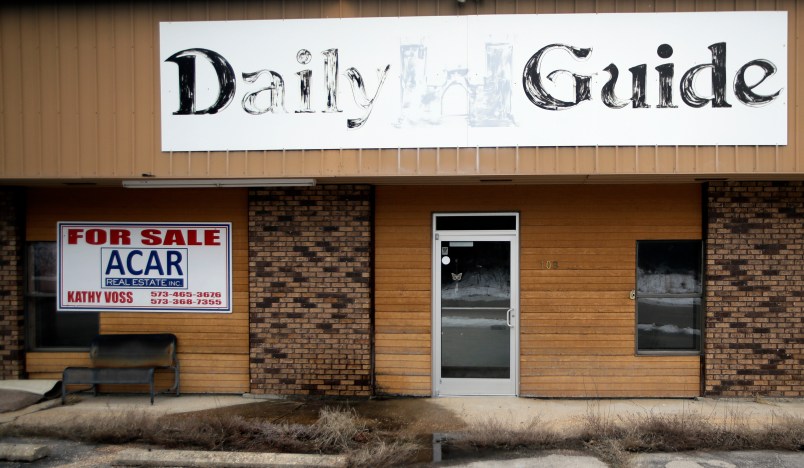WAYNESVILLE, Mo. (AP) — Five minutes late, Darrell Todd Maurina sweeps into a meeting room and plugs in his laptop computer. He places a Wi-Fi hotspot on the table and turns on a digital recorder. The earplug in his left ear is attached to a police scanner in his pants pocket.
Maurina, who posts his work to Facebook, represents the press — in its entirety.
He is the only person who has come to the Pulaski County courthouse to tell residents what their commissioners are up to, the only one who will report on their deliberations about how to satisfy the Federal Emergency Management Agency so it will pay to repair a road inundated during a 2013 flood.
Last September, this community in central Missouri’s Ozark hills became a statistic. With the shutdown of its newspaper, the Daily Guide, it joined more than 1,400 other cities and towns across the U.S. to lose a newspaper over the past 15 years, according to an Associated Press analysis of data compiled by the University of North Carolina.
The reasons for the closures vary. But the result is that many Americans no longer have someone watching the city council for them, chronicling the soccer exploits of their children or reporting on the kindly neighbor who died.
In many places, local journalism is dying in plain sight.
The Daily Guide, which traces to 1962, served the twin towns of Waynesville and St. Robert near the Army’s sprawling Fort Leonard Wood. It was a family owned paper into the 1980s before it was sold to a series of corporate owners that culminated with GateHouse Media Inc., the nation’s largest newspaper company.
As recently as 2010, the Daily Guide had four full-time news people, along with a page designer and three ad salespeople.
But people left and weren’t replaced. Last spring, the Daily Guide was cut from five to three days a week. In June, the last newsroom staffer, editor Natalie Sanders, quit — she was burned out, she said. The last edition was published three months later, on Sept. 7.
“It felt like an old friend died,” Sanders said. “I sat and I cried, I really did.”
The death of the Daily Guide raises questions not easily answered, the same ones asked at newspapers big and small across the country.
Did GateHouse stop investing because people were less interested in reading the paper? Or did people lose interest because the lack of investment made it a less satisfying read?
GateHouse said the Daily Guide, like many smaller newspapers across the country, was hurt by a dwindling advertising market among national retailers. It faces the same financial pressures as virtually every other newspaper company: Circulation in the U.S. has declined every year for three decades, while advertising revenue across the industry has nosedived since 2006, according to the Pew Research Center.
The challenges are especially difficult in smaller communities.
“They’re getting eaten away at every level,” said Ken Doctor, a news industry analyst at Harvard’s Nieman Lab.
The Daily Guide supplemented its income through outside printing jobs, but those dried up, too, said Bernie Szachara, president of U.S. newspaper operations for GateHouse. Given an unforgiving marketplace, there’s no guarantee additional investment in the paper would have paid off, he said.
Szachara said the decision was made to include some news about Waynesville in a weekly advertising circular distributed around Pulaski County.
“We were trying not to create a ghost town,” he said.
To residents of Waynesville, the loss of their newspaper left a hole in the community. Many are still coming to grips with what is missing in their lives.
“Losing a newspaper,” said Keith Pritchard, 63, chairman of the board at the Security Bank of Pulaski County and a lifelong resident, “is like losing the heartbeat of a town.”
Pritchard has scrapbooks of news clippings about his three daughters. He wonders: How will young families collect such memories?
Other residents talk with dismay about church picnics or school plays they might have attended but only learn of through Facebook postings after the fact.
“I miss the newspaper, the chance to sit down over a cup of coffee and a bagel or a doughnut … and find out what’s going on in the community,” said Bill Slabaugh, a retiree. Now he talks to friends and “candidly, for the most part, I’m ignorant.”
Beyond the emotions are practical concerns about the loss of an information source.
Like many communities, Waynesville is struggling with a drug problem. The four murders last year were the most in memory, and all were drug-related.
Without a newspaper’s reporting, Waynesville Police Chief Dan Cordova said many in the community are unaware of the extent of the problem. Social media is a resource, but Cordova is concerned about not reaching everyone.
It isn’t just local residents who notice the absence of community-based journalism. As the newspaper industry has struggled, a host of philanthropic efforts have begun to fill at least some of the gaps.
Whether any of those efforts ever help Waynesville and small towns like it remains to be seen.
After the Daily Guide folded, Waynesville briefly had an alternative. A local businessman, Louie Keen, bankrolled a newspaper, the Uranus Examiner, that was delivered for free. It was shunned by local advertisers and lasted just five issues.
So Waynesville is left with local radio and Maurina’s Facebook site. He says that for journalism to survive, reporters need to get back to the basics of being at every event and “telling everyone what the sirens were about last night.”
As “small newspapers wither and die, that’s going to cause major problems in communities,” he said. “Somebody needs to pick up the slack and, at least in this community, I’m able to do that.”
___
Associated Press Business writer Alexandra Olson in New York and video journalist Peter Banda, from Waynesville, contributed to this report.
___
Follow Dave Bauder at https://twitter.com/dbauder and David A. Lieb at https://twitter.com/DavidALieb



